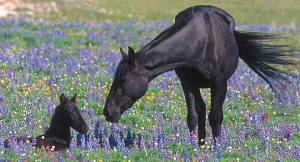 Recently I’ve begun updating some of the images in my colors section and getting in touch with the times when it comes to color. It’s a complicated ride, but it sure is a pretty one!
Recently I’ve begun updating some of the images in my colors section and getting in touch with the times when it comes to color. It’s a complicated ride, but it sure is a pretty one!
Basic Colors
Coloring in horses comes from a pigment called melanin which appears in two forms, eumelanin (black) and phaeomelanin (red). These two expressions are responsible for the two base horse colors, black and chestnut. All other coat colors come from an interaction between these two genes and that of various modifiers, dilutions and white patterns.
Warm Black Horses
Quite the opposite to us, dark animals do better in colder climates and most black breeds come from northern countries. Their skin tends to be more sensitive than other dark skinned animals and their coat absorbs the sun’s heat.

Non-Fading Black Vs. Fading Black
Although there have been various theories about non-fading black genetics, it is still unknown what causes some blacks not to fade. Both of them can be born lighter in color, however as they mature either their coat retains a blue-black sheen or it begins to redden with exposure to sun and sweat.
The best way to preserve a fading black coat is to feed them well, keep them out of the hot sun and wash sweat off immediately.
Learn More About Color
Be sure to visit the new and improved color section for more information about black horses and stay tuned, next week we’ll take a look at the other base color, chestnut.